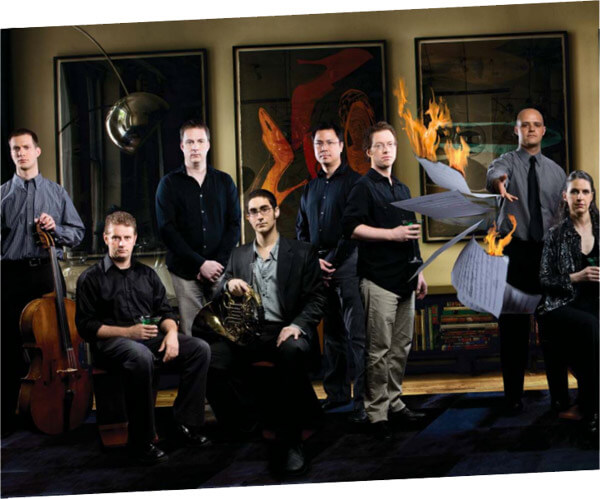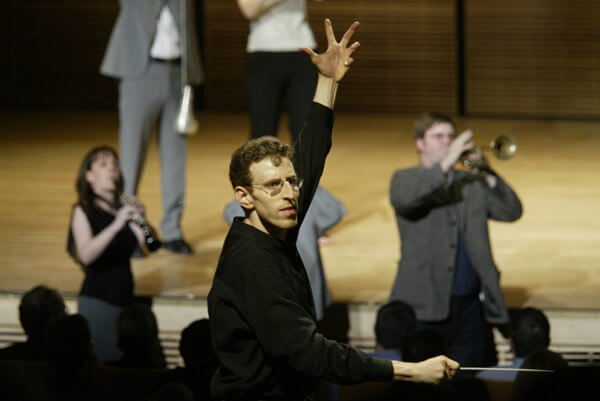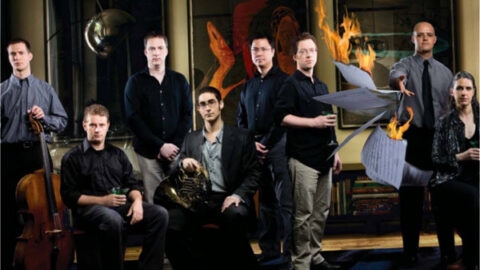 The new music ensemble Alarm Will Sound put on a concert of six contemporary works on Friday, October 21st (as a part of the SONiC new music festival) at the beautiful Art Deco theater hall of Roulette, located in the arts district of Brooklyn. As in most such concerts of new music, the different pieces were incredibly varied in length, structure, tonal language, and almost any other musical attribute one could think of. Additionally, though all 20 members of AWS played or sang or both on every piece, there were some differences between the pieces’ instrumentations: besides the usual doublings one expects from classical players (the flautist switching to piccolo, for instance), the concert included electric violin, electric bass, electric guitar, accordion, two vocal solos, and several instances of either backing vocals or strange gasps, sighs, and other nonstandard vocalizations from various members of the ensemble.
The new music ensemble Alarm Will Sound put on a concert of six contemporary works on Friday, October 21st (as a part of the SONiC new music festival) at the beautiful Art Deco theater hall of Roulette, located in the arts district of Brooklyn. As in most such concerts of new music, the different pieces were incredibly varied in length, structure, tonal language, and almost any other musical attribute one could think of. Additionally, though all 20 members of AWS played or sang or both on every piece, there were some differences between the pieces’ instrumentations: besides the usual doublings one expects from classical players (the flautist switching to piccolo, for instance), the concert included electric violin, electric bass, electric guitar, accordion, two vocal solos, and several instances of either backing vocals or strange gasps, sighs, and other nonstandard vocalizations from various members of the ensemble.

David T. Little’s Haunted Topography, a world premiere, was inspired by the story of a woman whose son was killed in the Vietnam War. She reported that not being able to see on a map the spot where he died made it impossible for her to find closure. The piece reflected the sensation of impossible, mournful longing through its careful craftsmanship. It began with a series of repeating high-register piano chords, pulsing at a slow tempo. Each chord repeated numerous times, but the harmonies did evolve, albeit slowly. Then the double bass entered, singing a slow, very sad, and every-so-slightly dissonant dirge. This theme would eventually be passed among the high winds, the trombone, and the violins at various times, even as the rest of the ensemble added themselves in to the now increasingly intense sound. The first time the piano hit a low note coincided with the entrance of the high winds, a particularly attention-grabbing effect. The pulsing chords continued throughout, but now in lower registers and eventually changing to a mix of eighth-note and triplet rhythms. Once the whole ensemble was playing, it seemed like the piece was going to reach its climax, but then the texture suddenly thinned and the volume decreased. The release of tension made it seem like the danger, the haunting, was passed, but then suddenly the entire ensemble returned, now displaying for the first time its true power. This true crescendo, an intense paroxysm of grief, featured everything from screeching violins, to dissonant chords in the brass and winds, to a pounding piano and bass drum. Finally, the whole thing faded and faded until finally all that was left was a single, long-held minor sonority, like a single precious memento of a lost loved one.
The US premiere of Nico Muhly’s Seeing is Believing featured violinist Caleb Burhans on the electric version of his instrument as the soloist. Clocking in at over 20 minutes, this piece was the most expansive and ambitious piece of a concert filled with cutting-edge works. Although not billed as such, it is, in essence, a very long single-movement concerto. The electric violin often played alone, beginning with a contemplative minor mode passage, sounding almost Middle Eastern in origin. The initial melody was looped using the foot pedal, and Burhans then repeated it with subtle rhythmic variation, creating a phasing effect. The second violin and viola entered with a dissonant, pizzicato “droplet” pattern. As the rest of the ensemble entered, the electric violin temporarily sat out, and these splashes of dissonant color from the high register instruments were interspersed with very recognizable major and minor chords. There followed a fragmentary dialogue, lead by the flute, between dissonant and consonant elements, the feeling of incompleteness heightened by the electric violin’s absence. When it finally returned, at first it was just as another member of the ensemble, but it quickly reasserted itself as the true leader, growing in volume even as the other strings played increasingly intense rhythmic pulsations.The interplay between the meditative and the whimsical, the simple and the virtuosic, the connected and the very staccato, was a powerful feature throughout Seeing is Believing. These contrasts were arranged not only horizontally, as the piece progressed through time, but also vertically: the most powerful tutti sections were dazzlingly kaleidoscopic, with ringing bells and horns, swirling flute and clarinet, pulsing strings, and soaring electric violin melodies all happening at once. It is a testament to Muhly’s skill as an orchestrator that, far from being confusing, these passages were enchanting and even deeply stirring.The piece culminated with an intense and brilliant arpeggio passage ending with 40 repeated high notes leading into the final section. This last part made particularly powerful use of the looping possibilities of an electric instrument, even as the rest of the ensemble began to drop out. The accompanying droplet pattern from the beginning was now transformed into a harmonious melody at the forefront, with only a soft accompaniment to bring to rest this soaring and gorgeous new work.
Drowning, by AWS cellist Stefan Freund, is a song from a work of musical theater about fear and xenophobia, but it stands extremely well on its own. AWS Violinist Courtney Orlando stepped up to the mike for this foray into dark, passionate intensity. The minor string riffs and traditional, held wind and brass chords vie with staccato moments of true dissonance; Freund proves he is no stranger to modern classical techniques, but he uses them sparingly, and the piece’s primary aesthetic is rock. Although the piece is sung from the point of view of a woman who is missing her lover, it conveys as much anger as sadness. In one refrain, she sings, “I miss you,” but in the next, her complaint is transformed into “Where the fuck are you?” repeated over and over again. In the end, the two lines alternate. This final crescendo subsides into a final plaintive plea to the absent one.

Aleksandra Gryka’s einerjedeneither was the most challenging of the evening’s fare, belonging firmly to the “extended techniques” school of modern composition. Filled with hisses, whistles, gasps, key clicking, multiphonics (singing while playing a wind instrument), drones, screeches, and so on, the piece worked hard at its incoherence: every time anything resembling a pattern began to emerge, it was ruthlessly cut off, to be replaced by something even more abstract. Similarly, there are moments of brightness and familiarity that shine through like stars on a cloudy night—they shimmer for a moment, but do not pierce the wall of pure strangeness, otherworldly and even frightening. The end of the piece was extremely effective: the two violinists, scraping their bows against the strings so softly that nothing was produced but a soft, inconsistent hissing sound. The audience, primed to expect a sudden, violent explosion of sound from the brass and percussion, based on what had happened previously, was on the edge of their seats. But their expectations are once again deceived, and the hissing finally fades to nothing. Paradoxically, this move did nothing to lessen the tension, and it took some time for everyone to realize that the piece was really over.
AWS horn player Matt Marks composed the next piece, and, like Freund’s Drowning, it is also a song from a larger work of musical theater. Marks put down his instrument and sang his “A Song For Wade (This Is Not That Song),” the hilariously inappropriate aria from the point of view of a sexually confused 16-year-old teenage boy. This character is simultaneously attracted to two men: his sister’s boyfriend (“she doesn’t deserve him!”), and the Internet interlocutor Wade (“he thinks I’m 19!”). The musical accompaniment is as sardonic as the words, veering from a 1950’s rock triplet feel to a schmaltzy string ballade to an epic ballad for the emotional climax of the song. There are moments of more sincere musicality as well, such as the lovely, pulsing arpeggios that separate the first chorus and the second verse. As the protagonist’s dilemma becomes ever more frustrating, the music grows more intense, and so too do the demands posed to the singer. But Marks’ strong tenor voice carried the piece, even into the straining upper registers. He managed to fuse his vocal talents, multifaceted compositional personality, and witty satire into something that seems like the ultra-sophisticated, musically schizophrenic pop ballad missing from Avenue Q.
In contrast with enerjedeneither, Omgyjya Switch, an arrangement by Evan Hause of a work by electronic artist Aphex Twin, conveyed a sense of coherent cacophony. It was also a perfect fusion of pop and classical, requiring both exquisite precision and arena rock levels of passion from the ensemble. Although often dissonant and jagged, the piece was primarily defined by its absolutely propulsive rhythmic energy—in fact, three percussionists just wasn’t enough for the multi-layered rhythms here, so many of the musicians doubled on percussion instruments. And, surprisingly enough, a solid melody, played by the brass, did eventually surface, like a submarine rising from a sea so turbulent that the existence of anything intact within it is nothing short of a miracle. It was quickly submerged back into the percussive waves, but nothing could have stayed afloat on such a texture for very long. Omgyjya Switch was a brilliant finale to the concert, because nothing else could possibly have followed it.
Although not every listener would find all of the works presented enjoyable or even engaging, almost everyone would find themselves swept away at individual moments by feelings of soaring joy, crushing despair, ribald jocularity, and desperate longing. In other words, this music felt continuous with traditions of centuries past, even as it sought new pathways. It rarely felt “academic” or distant, but neither were the pop elements gimmicky; none of it was austere, except when austerity better enhanced the emotional content of the works. In short, Alarm Will Sound successfully showcased the performers’ talent and enthusiasm for playing challenging modern works, as well as the state of the art of composition in the 21st century.
—
Matt Weber is a New York-based composer.
























